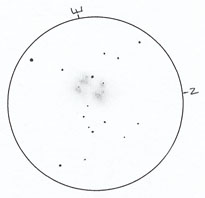 Copeland's Septet (Hickson 57) is the subject of the sketch at left. Six of seven members are shown in this rendering, which captures 199X and 272X views in the 18-inch Obsession. The brightest star in the field, 8.1 magnitude HD 101110, is stationed just inside the southeast edge. The galaxies are collected immediately to the west of an 11th magnitude GSC star near the center of the field. They're separated in two groups, three to the north and three to the south of center.
Copeland's Septet (Hickson 57) is the subject of the sketch at left. Six of seven members are shown in this rendering, which captures 199X and 272X views in the 18-inch Obsession. The brightest star in the field, 8.1 magnitude HD 101110, is stationed just inside the southeast edge. The galaxies are collected immediately to the west of an 11th magnitude GSC star near the center of the field. They're separated in two groups, three to the north and three to the south of center.
The northern trio includes NGC 3745, NGC 3746 and NGC 3748. NGC 3746 is largest and brightest, 14.2 magnitude and covering a 1'x0'.5 area. This barred spiral is aligned roughly southeast to northwest. Nearly 2' to the northeast, NGC 3748 is seen as a 15th magnitude smudge, 0'.5x0'.3 in size. Between these galaxies is NGC 3745. At about 15.2 magnitude and 0'.2 in diameter, this galaxy embodies the description, faint little stinker.
NGC 3750, NGC 3753 and NGC 3754 are clustered nearby to the south. NGC 3753 and NGC 3754 appear as a single v-shaped nebulous patch. In fact, NGC 3753 is cataloged as a 13.6 magnitude spiral and NGC 3754 as a 14.4 magnitude stellar metropolis. Less than an arcminute to the southwest, 14.2 magnitude NGC 3750 appears elongated east to west with a faint star along its northern edge. You'll find Copeland's Septet about a degree northwest of the naked eye star 92 Leonis. |
![]()
![]()
